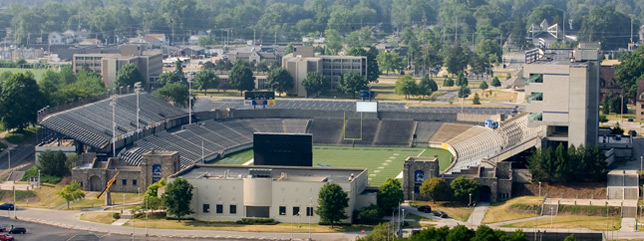 The Glass Bowl was built as a WPA project in the 1930s; it has undergone several renovations in the last 60-plus years. The most extensive of these came in 1990 when seating was expanded from 18,500 to the present capacity of 26,244. A three-story press tower was constructed and houses 40 executive loges and a 400-seat stadium club. Fans can watch a live, five-camera closed-circuit broadcast of Rocket games on the more than 75 television monitors throughout the tower. The third component of the $18-million project was the construction of a team facility building -- the Larimer Athletic Complex -- at the open end of the stadium horseshoe.
The Glass Bowl was built as a WPA project in the 1930s; it has undergone several renovations in the last 60-plus years. The most extensive of these came in 1990 when seating was expanded from 18,500 to the present capacity of 26,244. A three-story press tower was constructed and houses 40 executive loges and a 400-seat stadium club. Fans can watch a live, five-camera closed-circuit broadcast of Rocket games on the more than 75 television monitors throughout the tower. The third component of the $18-million project was the construction of a team facility building -- the Larimer Athletic Complex -- at the open end of the stadium horseshoe.
Football at The University of Toledo started in 1917 with an upsetting 145 to 0 loss to The University of Detroit. For twenty years, UT football teams were moved from one stadium to another including Armory Park, Waite Bowl, the Nebraska Avenue grounds, St. John's field, Swayne Field and Libbey Stadium.
Finally in 1937, The University of Toledo's football team resided in its permanent home on the University's Bancroft Campus. Construction of the field, which is set in a natural bowl, began in February of 1936 as a project of the Works Progress Administration during the Great Depression. The only means of construction were picks, shovels, and wheelbarrows. The original design of the stadium had a seating capacity of 11,000 fans. It now has the capacity to hold 26,248 fans!
The first game in the Rockets' stadium was on September 25, 1937. Grass had not yet been planted around the stadium and there were no walkways to the entrance. Thus, when heavy rainfall deluged the area mud blocked the gates and the game had to be postponed until the following Monday. The Rockets went on to beat Bluffton College, 26-0.
The Rockets' stadium is know as the "Glass Bowl" in recognition of Toledo's distinction of being the glass capital of the world. The stadium was not named the "Glass Bowl" until renovations in 1946. The origin of the name dates back to 1946 and a man named Wayne Kohn, an employee of the structural engineering department of the Libbey-Owens Ford Glass Co., who suggested an annual Glass Bowl football game to be played in the Rockets' stadium. Three Toledo glass manufacturing companies developed the idea further and with the University sponsored a "Glass Bowl" stadium, which was a renovation of the then current stadium.
The stone structures at the northeast and northwest corners of the Glass Bowl are called Blockhouses. In the past, the Blockhouses were used as a residence for the football players. The Rockets would stay in the west Blockhouse and the visitors would stay in the east Blockhouse.
The Glass Bowl is the oldest stadium in the Mid-American Conference. Over the years there have been many renovations made to the Glass Bowl, such as switching from grass to Astroturf in October of 1974; building an electronic scoreboard in 1975; adding seats in 1972; again adding seats, a press tower, luxury boxes, and Larimer Athletic Complex in 1990, and switching to NeXturf, an artificial surface carefully modeled after natural grass, in July of 2001. The outer wall and Blockhouses are all that remain of the original Glass Bowl Stadium.






































